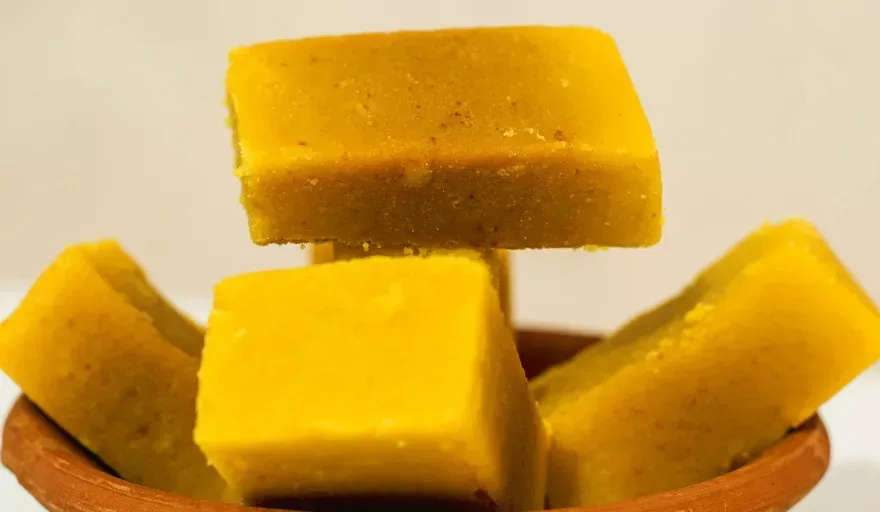Traditional sweets, known as mithai, are important in India. And that’s not just because most Indians have a sweet tooth. They’re given to guests at weddings, made as offerings at religious festivals. According to Hindus, the ingredients in mithai – such as sugar, milk and ghee – are considered ‘sattvic’ or pure, so they can be eaten by devotees, vegetarians and religious leaders.
Mithai also have the power to make or break fortunes. In 1868, a Bengali named Nobin Chandra Das created the rossogolla, a spherical sweetmeat made by boiling balls of chhana (similar to cottage cheese) in sugar syrup. The syrup permeates the chhana balls, giving them a spongy yet succulent texture. Soon, people were flocking to Nobin’s sweetshop, and he was spoken of with reverence as the ‘Columbus of Rossogolla’.
Nobin’s son, K.C Das, started a chain of sweet shops. In 1972, he set up the first K.C Das in Bangalore, on St. Mark’s Road. Fast forward 45 years and I was standing in the very same shop, looking at the array of sweets in bewildered interest. At the white rossogollas, as pale and spherical as moons, bobbing in vats of clear syrup. At kesar barfi, square milk sweets stained bright yellow with saffron. At kaju katli, diamond-shaped sweets made of powdered cashews and decorated with silver leaf.
We ordered rossogollas, and my fiancé’s favourite, gulab jamun – round balls like doughnut holes, drenched in rose-flavoured syrup. Both were so sweet they made my teeth ache, although I did enjoy the texture of the rossogolla, which squeaked in my mouth like halloumi.
The truth was, I found Indian sweets much too sweet. In upmarket restaurants I would order raspberry mousse or lemon tart, hoping for a refreshing tang that rarely materialised. I couldn’t imagine being able to eat more than one of the mithai that were occasionally gifted to us by friends or neighbours. But I had reckoned without Mysore pak.
The first time I tried it was on my wedding day, which involved a visit to the sub-registrar’s office on Bangalore’s Church Street – a stuffy room crowded with people waiting to get documents signed. Getting married was a complex, bureaucratic process requiring multiple documents, three witnesses, and a Kafkaesque array of officials, forms, signatures and stamps. To help us out, a family friend had put us in touch with his ‘middle-man’ who would help us navigate the process.
We followed him as he seamlessly pushed his way to the front of the crowd around each desk, somehow getting our forms noticed in the dense thicket of hands waving pieces of paper. I’m sure a few palms must have been surreptitiously greased throughout the process.
Finally, we were close to being done. My mother-in-law turned to my almost-husband.
“You have the Mysore pak for him?”
He shook his head.
“I’m sorry – we must have left it at the flat.”
“Oh God,” she said, agonised.
Bikram said he was pretty sure that the middle-man would prefer cold hard cash, but she was insistent. The best man was duly dispatched to K.C Das.
Ten minutes later, on the street outside, my father-in-law tried to press a 500 rupee note into the man’s hand. He refused, insistently. Perhaps he had been told by my father-in-law’s friend not to accept money. But nobody had said anything about Mysore pak, which he accepted gracefully.
Mysore Pak was invented for Krishnaraja Wadiyar IV, who ruled the Mysore Kingdom from 1894 to 1940. His head chef, Kakasura Madappa, wanted to make him a special mithai. He began experimenting with ghee, gram flour and sugar, which produced a sweet with a fudge-like consistency. The king was enraptured, and the sweet, which he named Mysore pak, soon appeared regularly at his table. He told the chef to open a sweet shop outside the palace grounds so that his subjects could try it too. His descendants still run a sweet shop in the city.
After the marriage had been made official, we spilled noisily out of the sub-registrar’s office and back to our flat for a lunch of pizza and champagne. Afterwards, Bikram pulled out the box of Mysore pak. Inside were rectangular sweets, yellow at the edges and slightly darker in the middle.
“Just have half. They’re quite rich,” he cautioned.
I broke off a corner. It dissolved in my mouth like butter. Underneath the saccharine punch, I detected hints of cardamom and the mild nuttiness of besan (chickpea flour).
“Too sweet?” Bikram asked.
“Yeah,” I said, cramming another piece into my mouth.
Two years later, I still don’t have much of a sweet tooth – by Indian standards, at least. But I’ll always make an exception for Mysore pak. Perhaps it’s because of the memories I associate with it. Or perhaps it’s because it’s a sweet fit for a king.





















